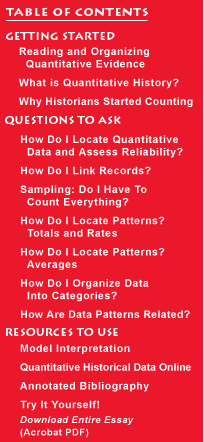
We observed
earlier that historians search for patterns in surviving evidence from
the past and that descriptive statistics can help in this process. But
historians are not always happy just locating a pattern. They frequently
want to explain the pattern; they want to know why the pattern emerged
and took the shape that it did. In common parlance, they want to know
the causes of the historical patterns they identify. And here again
quantitative methods can be useful so long as we are careful not to
treat statistical measures of association as the equivalent of historical
proof. With the help of statistics we can infer the existence of a relationship
between two variables or factors, but that does not mean that one factor
caused the behavior of the other. It remains possible that a
third variable was the "prime mover"; by just looking at two
variables, we run the risk of mistaking correlation for causation.
Even complex procedures that statisticians call "multivariate analysis,"
which can handle several variables at once, are not powerful enough
to prove historical causation to the satisfaction of most scholars.
With few exceptions, historians do not believe that historical causation
can be reduced to a formula, however complicated and sophisticated the
mathematical manipulation of the data may be.
Yet if we cannot prove historical causation by means of statistics alone,
we may still be able to use quantitative methods to help substantiate
or challenge assertions about historical causation that are commonly
expressed in qualitative terms. Although not all qualitative statements
about historical causation can be tested quantitatively, some can. The
key is to employ statistical tools in a reasonable, restrained, and
responsible manner. And do not be surprised if you find that you can
undermine a hypothesis more readily than you can come up with an alternative
explanation for the data. In history as in many other disciplines, undercutting
an argument or an interpretation is often easier than constructing one.
One of the first areas that attracted quantitative historians was the
study of voting behavior. The basic story of how Americans had voted
in the past was well known, but historians disagreed among themselves
about why people voted the way they did. Some historians argued that
Americans voted mainly according to their economic interests pure and
simple. Other historians contended that economic interests mattered
less than cultural factors, such as ethnic identity, religion, and philosophical
outlook. The "new political historians" sought to resolve
this debate by using quantitative methods. In particular, they matched
various quantifiable variables against the election results and measured
the level of correlation.
A coefficient of correlation indicates the strength of the relationship
between two variables. The most commonly used correlation coefficient
is the Pearson product-moment coefficient or Pearson r. While
it is difficult to calculate, it is rather easy to interpret. Essentially,
Pearson r can fluctuate between 0 and either +1 or – 1.
The sign (+ or -) of Pearson r indicates the kind of relationship
between the two variables. If Pearson r is positive, then the
two variables behave in tandem and in the same direction: that is, if
one goes up, the other goes up and if one goes down, the other goes
down. On the other hand, if Pearson r is negative, then the two
variables behave in tandem but in opposite directions: if one goes up,
the other goes down. The closer the coefficient of correlation is to
1 or –1, the stronger the association is between the two variables.
If Pearson r is 0, then there is no relationship between the
two variables.

In the
years following the end of the Civil War and emancipation, the question
of extending civil rights to African Americans dominated national life
in both northern and southern states. The use of quantitative evidence,
and particularly the technique of correlation, can shed light on how
some Americans felt about the pressing question of African-American
voting rights. Almost every northern state allowed voters (then only
white males) to vote on whether to extend voting rights to African-American
men. Robert R. Dykstra and Harlan Hahn studied one such referendum held
in Iowa in 1868. Using election returns and census data, they looked
for associations (correlations) between votes on the referendum to extend
voting rights and several political, social, and economic variables
such as party affiliation (Democrat or Republican), land values, and
population density. 66.5% of Iowa voters voted to extend suffrage to
African Americans in 1868 (up from 14.6% who voted that way on a similar
referendum held in 1857).
First they looked at party preference and economic factors (read and
roll mouse over):
















